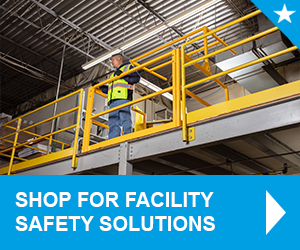
Ensuring that indoor walking and working areas are properly protected is crucial for Safety Managers. The Occupational Safety and Health Administration (OSHA) emphasizes the importance of machine guarding, a vital safety measure that, when combined with thorough training for both management and employees, significantly reduces the risk of dangerous falls. By complying with OSHA machine guarding guidelines, you not only protect your team, but foster a safer working environment.
What You’ll Learn from This Article:
- How OSHA’s regulations relate to machine guarding safety.
- The best uses of modular rails for equipment and warehouse safety gates.
- Training programs to ensure fall prevention and proper use of equipment.
Understanding OSHA Machine Guarding Safety Regulations:
To start, OSHA Regulation 1910.212(a)(1) states:
“Types of guarding. One or more methods of machine guarding shall be provided to protect the operator and other employees….”
Additionally, according to OSHA Regulation 1910.212(a)(2):
“General requirements for machine guards. Guards shall be affixed to the machine where possible and secured elsewhere if for any reason attachment to the machine is not possible. The guard shall be such that it does not offer an accident hazard in itself.”
These regulations have evolved over the years to include safety measures for specific equipment across different industries. Safety Managers should be sure to routinely review these policies.
Why Machine Guarding Safety Products Should Be Used in Work Areas
Imagine you’re managing Stanley, a new employee on your worksite who hasn’t been properly trained in safety protocols. One day, Stanley makes the decision to carry a few heavy steel beams down a crowded walkway next to a conveyor system that has sharp protrusions and exposed gears.
Stanley, rushing to get the beams to where they need to be, loses his balance and winds up seriously injuring himself on the gears. After an investigation, it’s determined that OSHA regulations requiring proper machine guarding were neglected, leaving the company legally liable and potentially responsible for paying hefty fines.
Your facility can avoid this type of situation by:
- Using Modular Rails for Safety: Modular rails for equipment such as conveyor systems is a great way to be compliant with OSHA machine guarding regulations.
- Providing Proper Training: Employees should be trained continuously to prevent serious accidents on the worksite.
- Reviewing Regulations: Staying current on OSHA and CCOHS regulations that govern your operations can ensure you are prepared in all situations that may arise on your worksite.
Important When Considering Modular Guardrails: In particular, using modular guardrails for equipment can be a cost-effective, easier to install and will cause no disruption to the workflow in your warehouse as opposed to installing permanent guardrails in your facility for machine guarding safety.
By strategically implementing these around machines in a facility, the above scenario could have gone like this:
A few months later at the same warehouse facility, Stanley was back at work and had to move large pallets with a forklift. Although OSHA machine guarding safety precautions were put in place for the conveyor system, the work area was still more crowded than it should have been.
Stanley was unloading the pallets from the forklift onto the raised platform. In a moment of trying to carry too much at once, he lost his balance, but because the modular rails were properly installed a serious accident was avoided.
Since there were no warehouse safety gates present, modular guardrails were installed to prevent these types of falls.
How Proper Safety Equipment Helped:
- Fall Prevention: The modular guardrails were there to protect Stanley from falling from the elevated platform while carrying the pallets. He was able to regain his balance by stabilizing himself on the guardrail.
- Machine Guarding Safety for Equipment: Since the conveyor system was now properly protected by guardrails, even though the work area was still crowded, Stanley did not face the same injury risk as he did previously.
Taking the proper precautions not only kept Stanley safe after his return to the worksite, but it also ensured compliance with OSHA guidelines.
How to Combine Proper Training with Machine Guarding Safety Products
- Safety Managers should conduct new hire training for all employees on how to effectively use products such as modular guard rails for equipment and warehouse safety gates.
- Leadership should conduct New Safety Manager training, to provide new managers with everything they need to know about OSHA regulations and guidelines, product safety and how to train employees.
- Continuing education events should be held throughout the year for tenured employees on fall prevention safety as well as updated product information.
Get the MODULAR SAFETY RAIL Solutions You Need from Tractel
Fabenco by Tractel specializes in modular rails for equipment as well as warehouse safety gates to help companies fulfill their mission without compromising on safety or efficiency. If you have questions or would like to request a quote, contact us, and speak with one of our knowledgeable safety specialists today.





